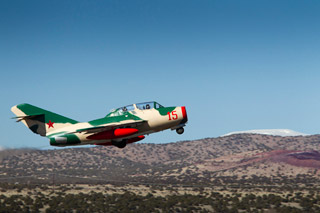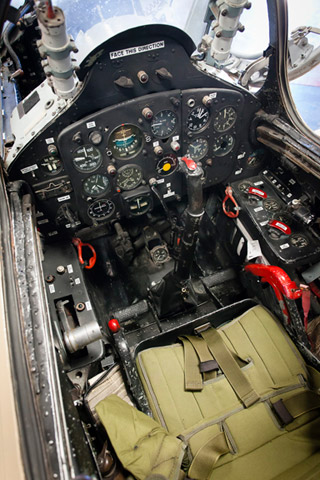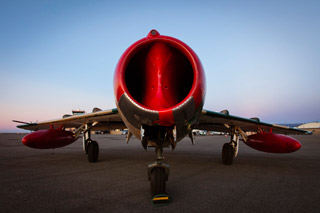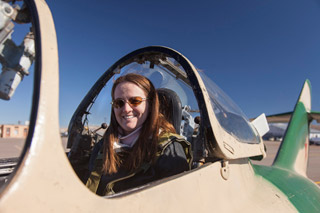 The MiG-15 was the first Soviet fighter to have an ejection seat, pressurized cockpit, and swept wing.
The MiG-15 was the first Soviet fighter to have an ejection seat, pressurized cockpit, and swept wing.
The rear seat of the Mikoyan-Gurevich MiG-15 feels like a booby-trapped cage compared to the spacious Aero Vodochody L-39 Albatros with its bulbous canopy. Unlike the L-39 that I flew as an introduction to jet warbird training, the MiG-15 has hot ejection seats. Even though the pin is still in my seat as I strap in, I’m careful to maneuver the belts away from the ejection handle, conscious that I’m sitting above a canister filled with gunpowder (the 1940s-1950s era technology for an ejection seat).
The Mikoyan-Gurevich MiG-15, designed in 1946, was the Soviet Union’s rival to the United States’ F-86, and its turbojet engine was based on the Rolls-Royce Nene. It was the country’s first aircraft with an ejection seat, pressurized cockpit (albeit lightly pressurized), and swept wing. The fighter entered Soviet Air Forces service in 1948, according to the Smithsonian National Air and Space Museum, and was first used against the United States in 1950 during the Korean War. More than 12,000 MiG-15s, and the aircraft’s many versions, were built in the Soviet Union, Czechoslovakia, Poland, and China; the Chinese version was called the J-2, according to the Smithsonian.
 Equipped with hot ejection seats, the MiG-15’s cockpit feels more like a booby-trapped cage.
Equipped with hot ejection seats, the MiG-15’s cockpit feels more like a booby-trapped cage.
An enemy fighter in generations’ memories and the history books, the MiG-15 is flown in the United States today as an experimental aircraft, a jet warbird with a powerful ramp presence. I’m flying with Larry Salganek, owner and flight instructor of Jet Warbird Training Center in Santa Fe, N.M., in a two-seat SB Lim-2 version of the UTI MiG-15 trainer that was remanufactured in the 1950s in Poland. It’s powered by at 5,300 pound thrust Lis-2SB engine, and costs the same as some older piston singles—$50,000 and $60,000. Salganek is giving AOPA a complimentary, abbreviated introduction to the type of training he provides to pilots seeking type ratings in the Aero Vodochody L-29 Delfin and L-39 Albatros, Lockheed T-33 T-Bird, Fouga Magister, and MiG-15.
Salganek, who has instructed in the aircraft since 1995, briefs me on the ejection procedure during a one-day ground session, but it’s an egress option that we’ll use only as a last resort: Most civilians who have ejected from MiG-15s did not survive, he says. Salganek pulls the ejection seat’s pin before closing my canopy. I make this flight in the rear seat of the dual-control MiG-15 that has nearly identical instrumentation in the front and back. Salganek allows only experienced jet pilots or those who have completed three or four hours of training in the L-29 or L-39 to sit in the front seat on the first flight in the MiG-15. It’s too easy for things to go terribly wrong quickly in the MiG.
“These airplanes are inherently dangerous,” he says. “Disneyland takes something that’s safe and gives you the illusion that it’s dangerous. We take something that’s dangerous and give you the illusion it’s safe.”
Inside the cockpit
 What’s up with the attitude indicator? Brown is on top and blue is on the bottom.
What’s up with the attitude indicator? Brown is on top and blue is on the bottom.
Seated in the rear cockpit, one of the few placards that I can easily read is an aftermarket sticker straight ahead that says “Face this direction.” Other placards and markings are in Cyrillic. That would be why he encourages me to “stay visual” in the aircraft. To a U.S. pilot, some of the instrumentation can create confusion: The Soviet-era attitude indicator is the opposite—brown on top and blue on the bottom. That could spell disaster for an unfamiliar pilot trying to recover from an unusual attitude in instrument meteorological conditions.
Using the attitude indicator in visual conditions, however, isn’t too difficult. As the aircraft pitches up, the card rises, revealing more blue and less brown. I use the instrument sparingly, only to initially establish the degrees of climb Salganek desires.
Fuel gauges are identified by a yellow dot on the instruments and the oil pressure indicator with a brown dot. The gauges don’t have the familiar green arcs for normal operating ranges. Instead the absence of a thin white arc indicates the acceptable range of operation.
Surprising limitations
When it was first introduced in the Korean War, the MiG-15 may have seemed invincible against the United States’ piston aircraft and early jets until the F-86 made it onto the scene—when the Soviet fighter suffered a 10:1 loss ratio, according to the Smithsonian. But the MiG has a number of limitations and quirks that make it a handful on the ground and in the air.
 Jet Warbird Training Center’s SB Lim-2, the Polish version of the UTI MiG-15, has drop tanks to carry extra fuel. The additional tanks give the jet 1.5 hours of fuel.
Jet Warbird Training Center’s SB Lim-2, the Polish version of the UTI MiG-15, has drop tanks to carry extra fuel. The additional tanks give the jet 1.5 hours of fuel.
The turbojet “burns as much fuel on the ground as it does in cruise,” Salganek says, explaining that this aircraft, which holds 450 gallons with the drop tanks, burns about 5 gallons per minute. That gives us 1.5 hours of fuel on board, or about a 45-minute flight counting start-up, taxi, and required landing reserves. “My watch starts when the engine starts,” he says, “and you fly the MiG with your watch.”
The MiG can cover 350 nautical miles in one hour, but cross-country planning is difficult because of the runway lengths and services it requires. Jet fuel and nitrogen must be available at each point of landing. (The wheels’ drum brakes operate off nitrogen that must be replenished before every flight.) The MiG-15 needs at least 5,000 feet of runway at sea level, and 8,000 feet at 6,000-feet elevations like in Santa Fe. If a pilot experiences a problem shortly after takeoff, a safe landing could be precluded. “The brakes are OK for 1947, but they aren’t made to come back and land with full fuel,” he continues.
Winds are another limiting factor, Salganek says. Because the ailerons are ineffective at slow airspeeds, the MiG doesn’t have enough aileron effectiveness to land in strong crosswinds.
“We’re always concerned about leaving ourselves margin,” Salganek says. Because of these limitations, limitations one wouldn’t imagine a fighter having, pilots must set personal minimums, fly within the jet’s limitations, and always analyze “what’s safe, what’s not safe” to do in the aircraft.
Happy highs, slow lows
The turbojet is slow to accelerate; on takeoff I use 1,500 feet of runway before rotation verses 1,000 feet in the L-39. Once the engine starts accelerating, however, it leaves the L-39 in the dust. As we approach 120 knots to 125 knots, I prepare to rotate. Pilots have a tendency to over-rotate the MiG-15, which can put the aircraft in a dangerous attitude—an angle of attack so high the jet can’t climb or accelerate, causing it to crash off the end of the runway.
I barely apply backpressure to lift the nosewheel off the runway, perfect for the climb-out. The aircraft is more stable in pitch, preventing the pilot-induced oscillations that I had in the L-39, but its ailerons, with hydraulic boost, are easier to roll.
 The MiG’s famous mug commands the attention of any pilot.
The MiG’s famous mug commands the attention of any pilot.
The aircraft is less responsive and difficult to handle at low airspeeds, I learn during a slow flight maneuver. After I make gentle turns at 140 knots, Salganek takes the controls for a moment, deflecting the stick full left and full right. The MiG just wallows, barely rolling a few degrees. I try it myself with the same results. Even with two stall fences on each wing, the ailerons are ineffective at slow airspeeds (A third row was added to the MiG-17, which considerably helped the low-speed handling characteristics, Salganek says.). It’s an eye opener of what to expect on final approach to landing 10 knots slower at 130 knots. (I can also see why it can’t handle more than a 20-knot crosswind.)
Slowing to 120 knots, I stall the aircraft. It usually breaks to the left, Salganek says, but this time the right wing drops. Bring the throttle full forward, slightly lower the nose to recover. It takes a while for the turbojet to accelerate after operating at low power settings, but after my airspeed increases to 160 knots, Salganek raises the flaps. It will feel “as if the bottom has dropped out from underneath you, but it hasn’t,” he says. It feels as if I’m falling tail first toward the earth, but the aircraft hasn’t sunk. “The rate of climb stopped for momentarily,” Salganek explains, noting that the altimeter never decreased.
At the opposite end of the speed spectrum, the MiG performs beautifully.
In a powered dive, I reach Mach 0.85 before leveling off to perform a series of high-speed turns. At the upper reaches of the MiG’s speed range (this aircraft’s upper limit is lower because of the drop tanks), its controls feel balanced and responsive.
Return to earth
Salganek walks me through an overhead approach to Santa Fe Municipal Airport, but we then break off for a couple of go arounds in a normal traffic pattern configuration. He teaches the normal traffic pattern because not all tower controllers may be familiar with overhead approach procedures and the procedure may not be feasible at nontowered airports when traffic is following a typical pattern.
Reducing the throttle to 85-percent power and slowing to 240 knots on downwind at 8,000 feet, we lower the gear midfield. Full flaps come in abeam the 1,000-foot markers, the aiming point in the MiG-15. The MiG handles better with full flaps in the pattern, Salganek says. With the flaps extended, I slow the MiG to 160 knots.
 Successful first flight in the MiG-15.
Successful first flight in the MiG-15.
“Now you feel her rockin? That’s one of its features, its wonderful enduring features,” Salganek says. The “slight snaking motion,” as the aircraft basic flight manual describes it, continues through the rest of the pattern. Turning final, I wait to raise the nose to slow the aircraft to a final approach speed of 130 knots, remembering the aileron ineffectiveness experienced during slow flight. I keep the airspeed at 150 knots until I’m lined up on the centerline and level the wings, and then raise the nose. “Gentle movements,” Salganek coaches. “Perfect, you’re doing just perfect.” Even with an 8,000-foot runway, there’s little room for airspeed deviation—plus or minus 4 knots.
Seated in the back, I lean left to keep the runway in sight, but I try to minimize my control inputs, not that any deflection of the ailerons would have made a difference at 130 knots. A couple hundred feet above the runway, Salganek takes the controls to land, because the aircraft has blocked my view of the strip. There are no touch and goes in the MiG unlike the previous day in the L-39. The MiG takes the full runway as we roll out, the 1947 brakes struggling to slow the aircraft. It’s slow to accelerate and just as slow to decelerate.
“If you touch down at the 4,300 mark, you’re not stopping it on the runway,” he says. “You go off the runway in a jet, you’re gonna die. Our penalties are severe.”
Jet type rating
Applicants for a type rating in the MiG-15 need at least a private pilot certificate, instrument rating, 1,000 hours total time, and 500 hours as pilot in command, along with the necessary endorsements. Some pilots who come to Salganek for training still need a high-altitude endorsement; Salganek says he can work that into the training.
“Not everyone can fly a jet but most people can,” Salganek explains. “Most private pilots can handle an entry-level jet.” Salganek, who is also an FAA examiner for jet warbird type ratings, says he has granted a jet rating to private pilots. The MiG-15/17 (the MiG-17 is a single seat version) is not an entry-level jet. “You don’t want to take someone who has a limited number of hours and put them in a MiG,” he says. “You want to match the plane with their abilities.” That’s why he often starts pilots without jet experience in the L-29 or L-39 jet trainer.
After a total of 1.8 hours of jet time with Salganek split between introductions to the L-39 and MiG-15, I understand why pilots should not begin training in the MiG without prior jet experience. The L-39 is much more stable and forgiving, for a jet. Even so, the L-39 can’t fully prepare a person for the MiG transition. Salganek jokes that after spending three to four hours in the L-39, he puts students in the MiG “and go back to square one.”

Santa Fe, N.M., home of the Jet Warbird Training Center, offers a beautiful backdrop for fighter flights.



